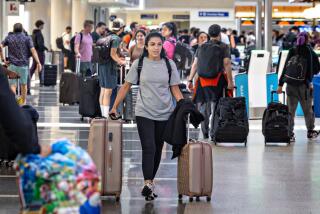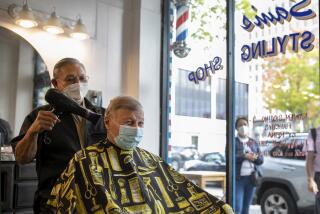When will you feel safe to travel? 5 epidemiologists share hopes, fears, data and guesses

- Share via
How do you measure the risks of pandemic travel, and when will the time be right to go again?
We asked five infectious disease experts, including one who hadn’t left home in four days, one who has taken two Mexican vacations since March and one who recently awakened from a COVID/Disneyland nightmare.
The first thing we must do, they agreed, is stay close to home for at least several more months, get vaccinated, and watch virus transmission and ICU numbers closely. Putting down the pandemic in California and elsewhere, they said, will depend on how faithfully we use masks, keep our distance and wash our hands — habits that will remain vital as authorities strive to vaccinate 300 million or more Americans by summer.
“I will never get on an airplane again without a mask,” said Dr. Kimberly Shriner, an infectious disease specialist at Huntington Hospital in Pasadena.
“Now is not the time to be traveling. For leisure or business,” said Dr. Luis Ostrosky, a professor of infectious diseases at McGovern Medical School at UTHealth in Houston.
If you fly now, said Dr. Krutika Kuppalli in Charleston, S.C., “you can almost guarantee that there are going to be people on the airplane with you who have COVID.”
These experts all are wary of new variants of the virus. None is flying now. Three have spent recent months within 120 miles of their home, as authorities urge all Californians to do. (That advisory remains in place, despite Gov. Gavin Newsom’s loosening of many restrictions on Jan. 25.) But their perspectives vary.
The numbers he watches
Ostrosky, born in Mexico City, has a lot of family there. So when his grandmother died recently, he thought about making the trip south. Mexico is one of the few countries Americans can visit without a mandated quarantine.
Get inspired to get away.
Explore California, the West and beyond with the weekly Escapes newsletter.
You may occasionally receive promotional content from the Los Angeles Times.
But he didn’t go because of the pandemic. After much talk, he stayed put in the U.S. Before he resumes travel, he said, he’ll ask several questions.
What’s the positivity rate? “I would avoid traveling to any place that has a positivity rate over 5%,” he said. Above that, “you dramatically increase your chances of exposure.” California’s seven-day average positivity rate — the number of COVID tests that yield positive results — was 12.4% on Jan. 27.
How full and how capable are the hospitals? Scores of U.S. hospitals are at surge capacity, with shortages of ICU beds. Because most county governments report COVID information daily, Ostrosky said, “it’s actually pretty easy” to find data. As for capability, any hospital with a Level 1 trauma center (the most comprehensive trauma care) would satisfy him, Ostrosky said. The American College of Surgeons maintains a database.
Does this destination require testing to enter or leave? Many travelers might hope for that, but “I just don’t want to get stuck somewhere,” Ostrosky said. “People can test positive for a long period of time without being infectious.”
This is now a factor in any flight to the U.S., including returning round-trip flights. As of Jan. 26, the U.S. Centers for Disease Control requires all air travelers to show a recent negative COVID test result before they can board any flight heading to the U.S.
What haunts a doctor’s dreams?
Shriner, who also is a tropical disease specialist and director of the Pasadena Travel Medicine clinic, has been vacationing in Europe for years and has spent more than 20 years making regular visits to a medical project in Tanzania.
But at Huntington Hospital, ever since the holidays, “we’re just absolutely getting hammered with cases of people who traveled,” she said.
Outside the hospital, Shriner has done some driving around California, but hasn’t flown since March. Like her colleagues, she believes that driving (especially if you bring food and avoid public toilets) is safer than flying and much safer than cruise ships (most of which are idle now).
Like Ostrosky, she wants to see a positivity rate of 5% or less at her departure point and at her destination. For data, she recommends the Johns Hopkins University Coronavirus Resource Center.
Shriner likes the idea of airlines and destinations requiring negative test results or vaccination. Whether or not those are required, Shriner said, people should get vaccinated, wait at least four weeks (to allow resistance to strengthen), and consider their age and immunity history before making travel plans.
In darker moments, she said, she worries that “this could just go on for another year or two if people don’t widely accept the vaccine.” She also shared a recent nightmare: She was on the Pirates of the Caribbean ride at Disneyland (which remains closed) surrounded by unmasked strangers.
On the brighter side, she’s hopeful that travel might be safe as soon as late summer or early fall. “But it is all dependent on human behavior,” Shriner said, “and we know how unreliable that is!”
What keeps Dr. Kuppalli home
Kuppalli moved in August from the San Francisco Bay Area to Charleston, where she is an assistant professor in the division of infectious diseases at the Medical University of South Carolina. She grew up in the Bay Area and had planned to visit her parents there this month.
Then the numbers surged. “I decided not to travel,” she said in mid-January. “I haven’t left my house in the last four days.”
To assess risk, “you can’t look at one particular piece of information,” she said. “You have to look at the entire thing. ... I totally get that this is hard for everybody. But this is not the time to travel. We all need to be thinking not just about ourselves, but everybody.”
Escaping the purple tier
Before Dr. Nancy Binkin became a professor at the Wertheim School of Public Health and Human Longevity Science at UC San Diego, she lived for 12 years in Italy, doing epidemiology training for the Italian National Institute of Health.
So when that country’s fatalities soared in the early weeks of the pandemic, followed by escalating U.S. numbers, “it put fear into me,” Binkin said. “I have not been out of San Diego County since March.”
One pandemic number she watches closely is the adjusted case rate. That count measures the seven-day average of daily new cases per 100,000 people (jails and prisons excluded). Any number above seven per 100,000 puts a county in the state’s most dangerous category, the purple tier. On Jan. 27, California’s statewide rate was 71.6 per 100,000. Before she travels, Binkin wants to see that number below seven.
When it comes to flying, she worries about jet cabins and tiny bathrooms, but perhaps even more, she worries about the lines of people and gathering points at airports, she said.
Get The Wild newsletter.
The essential weekly guide to enjoying the outdoors in Southern California. Insider tips on the best of our beaches, trails, parks, deserts, forests and mountains.
You may occasionally receive promotional content from the Los Angeles Times.
“Would I feel comfortable going down to Mexico? No,” she said. “I wouldn’t.”
About that second trip to Mexico
Dr. W. David Hardy, former director of Cedars-Sinai Medical Center’s infectious diseases division and adjunct clinical professor at USC’s Keck School of Medicine, has mixed feelings.
He’s angry about “rampant disregard for science” and inconsistent messaging under the Trump administration. But Hardy sees great hope in the vaccines.
When he was treating HIV patients during the grimmest years of the 1980s, Hardy recalled, there was no such cause for encouragement.
“To have a vaccine [that prevents] 90-95% of people from getting sick is amazing,” Hardy said. He suggests that the vaccines are “going to be the final answer,” especially if the vaccines thwart transmission of the virus as well as block symptoms.
Yet “the metrics for measuring transmission are ever changeable, and it may be difficult planning travel based on those,” he said. “They are going to be fluctuating for a while. I would say from six months to a year.”
Since March, Hardy said, he has scrubbed trips to Europe, North Africa and Hawaii. But in September, after California’s first surge had passed, Hardy and his partner flew to Los Cabos, in Baja California, for a vacation. It went well. So in December Hardy and his partner flew again, this time to Cancún and Playa del Carmen on Mexico’s east coast, where they found “the local people there were using masks religiously.”
The other visitors? Not so much.
“I would say 50-60% of the tourists were completely ignoring the mask requirements.”
Most of them were Americans, Hardy said, and he began asking people to put on their masks — or if they had no mask, “to step away from where I was standing.”
“The whole experience was “confusing and disconcerting,” he said. “When I got home from my second trip to Mexico, I turned to my partner and said, ‘This is not a good time to travel.’ … People are not adhering to what they should be adhering to.”
In some respects, Hardy said, that behavior reminds him of the 1980s when HIV was new. Then as now, he said, “until one of your friends, family or work associates dies of this disease, you still look at it as a sort of distant thing that doesn’t affect you.”
More to Read
Sign up for The Wild
We’ll help you find the best places to hike, bike and run, as well as the perfect silent spots for meditation and yoga.
You may occasionally receive promotional content from the Los Angeles Times.







